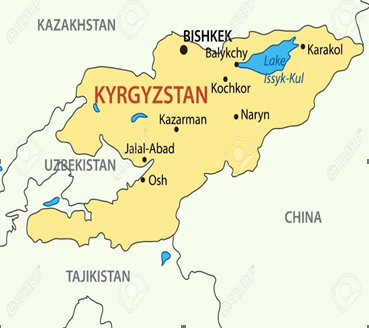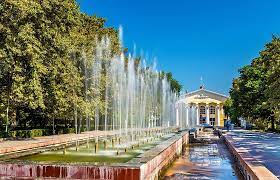The world is a busy place, with politics changing and events happening all the time. However, we make it simple to quickly read all the pertinent data for every country, in addition to flag details and an atlas summary for what kind of general information you are most interested in.
The following basic facts and information are covered in detail in each Country’s Profile:
Maps, geography, Brief history, the current ruler, area, population, capital, and largest cities – Languages-Race and ethnicity – Faith – Rate of literacy and The economy.
Facts & Information about Kyrgyzstan
Let’s explore everything you need to know about Pakistan. Check out our country profile, full of essential information about Oman’s geography, history, government, economy, population, culture, religion, and languages.
Flag Of Kyrgyzstan

Map Of Kyrgyzstan

President:Almazbek Atambayev (2011)
Prime Minister: Temir Sariyev (2015)
Total area: 73,861 sq mi (191,300 sq km)
Population (2014 est.):5,604,212; (growth rate: 1.04%)
Birth rate: 23.3/1000
Infant mortality rate: 28.71/1000
Life expectancy: 70.06
Capital and largest city (2011 est.): Bishkek, 839,000
Monetary unit: Som
National name: Kyrgyz Respublikasy
Languages: Kyrgyz (official) 64.7%, Uzbek 13.6%, Russian (official) 12.5%, Dungun 1%, other
8.2% (1999 census)
Ethnicity/race: Kyrgyz 64.9%, Uzbek 13.8%, Russian 12.5%, Dungan 1.1%, Ukrainian 1%, Uygur
1%, other 5.7% (1999)
Religions: Islam 75%; Russian Orthodox 20%; other 5%
National Holiday: Independence Day, August 31
Literacy rate: 99.2% (2009 est.)
Economic summary: GDP/PPP (2013 est.): $14.3 billion; per capita $2,500
Real growth rate: 7.4%
Inflation: 6.8% (2013)
Unemployment: 8.6% (2011 est.)
Arable land: 6.38%
Agriculture: tobacco, cotton, potatoes, vegetables, grapes, fruits and berries; sheep, goats, cattle, wool
Labor force: 2.344 million (2007); agriculture 48%, industry 12.5%, services 29.5% (2005 est.). Industries: small machinery, textiles, food processing, cement, shoes, sawn logs, refrigerators, furniture, electric motors, gold, rare earth metals
Natural resources: abundant hydropower; significant deposits of gold and rare earth metals; locally exploitable coal, oil, and natural gas; other deposits of nepheline, mercury, bismuth, lead, and zinc
Exports: $1.881 billion (2013 est.): cotton, wool, meat, tobacco; gold, mercury, uranium, natural gas, hydropower; machinery; shoes
Imports: $5.082 billion (2013 est.): oil and gas, machinery and equipment, chemicals, foodstuffs
Major trading partners: UAE, Russia, China, Uzbekistan, Kazakhstan, Afghanistan, Turkey (2012)
Communications
Telephones: main lines in use: 489,000 (2012); mobile cellular: 6.8 million (2012)
Broadcast media: state-run television broadcaster operates 2 nationwide networks and 6 regional stations; roughly 20 private TV stations operating with most rebroadcasting other channels; state-run radio broadcaster operates 2 networks; about 20 private radio stations operating (2007)
Internet Service Providers (ISPs): 115,573 (2012) Internet users: 2.195 million (2009 )
Transportation
Railways: 470 km (2010)
Highways: total: 34,000 km (2007 est.)
Waterways: 600 km (2010). Ports and harbors: Balykchy (Ysyk-Kol or Rybach’ye)
Airports: 28 (2013)
International disputes: Kyrgyzstan has yet to ratify the 2001 boundary delimitation with Kazakhstan; disputes in Isfara Valley delay the completion of delimitation with Tajikistan; delimitation of 130 km of border with Uzbekistan is hampered by serious disputes around enclaves and other areas.
Geography
Kyrgyzstan (formerly Kirghizia) is a rugged country with the Tien Shan mountain range covering approximately 95% of the whole territory. The mountaintops are perennially covered with snow and glaciers.
Kyrgyzstan borders Kazakhstan in the north and northwest, Uzbekistan in the southwest, Tajikistan in the south, and China in the southeast. The republic has the same area as the state of Nebraska.
History
Originally from Turkey, the Kyrgyz people settled in the Tien Shan mountains. Traditionally, they were nomadic pastoralists. Russian settlers received a large portion of the best agricultural land because of their widespread colonization in the 1900s. The Kyrgyz people’s catastrophic and futile insurrection in 1916 resulted from this. In 1924, Kyrgyzstan joined the Soviet Federated Socialist Republic, and in 1926, it was granted independence. In 1936 it was admitted as a component republic of the USSR. The Kyrgyz were compelled by the Soviets to give up their nomadic way of life and embrace contemporary industrial and agricultural methods.
On August 31, 1991, Kyrgyzstan declared its independence from the Soviet Union. Kyrgyzstan became a member of the Commonwealth of Independent States on December 21, 1991. In 1992, the nation enacted an economic shock therapy program and joined the UN and IMF. In a referendum held in January 1994, voters approved market reforms, and in a 1996 referendum, the majority of voters approved proposed constitutional amendments that increased the president’s authority.
There is an economic and ethnic gap between the destitute south, home to Uzbeks and a variety of other ethnic groups, and the more developed north, home to the Kyrgyz people. In 2003, almost half of the population was living below the poverty level.
Based in base camps in the highlands of Kyrgyzstan, radical Islamic gunmen have been conducting kidnappings and raids since 1999. They are thought to be from Tajikistan or Uzbekistan.

Leave a Reply